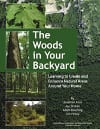 The Woods in Your Backyard: Learning to Create and Enhance Natural Areas Around Your Home
The Woods in Your Backyard: Learning to Create and Enhance Natural Areas Around Your Home
Written by Jonathan Kays, Joy Drohan, Adam Downing, Jim Finley; Published by NRAES (Natural Resource, Agriculture, and Engineering Service)
Reviewed by Peggy Newfield
This book is for landowners of one to ten acres of forested, semi-forested, or non-forested land who wish to promote and restore ecologically sound and healthy forested environments for the trees, shrubs and plants, and wildlife on the land, and themselves as they inhabit and use the land.
Structured as a primer and workbook, the book uses two case studies throughout to illustrate the process and activities needed to define goals for the land and its use, how to evaluate and inventory the land, determine desired projects (along with the physical, and financial requirements of each project and expertise needed), and how to prioritize those projects.
The primer part of the book has four sections – Introduction, Inventory Your Property, Ecological Principles, and Put Your Knowledge into Practice. Part I, the Introduction begins with a helpful section on defining goals, determining if your family is in with the program, and analyzing the goals based on Resource Benefits (natural area improvement, forest products, wildlife habitat, water resources, recreation and aesthetics) and Human Values (income production, enhanced property value, personal satisfaction, privacy and sanctuary, reduced lawn mowing).
In Part II, Inventory Your Property, information is provided on how orient your land within a larger landscape, and define the land management units within your property. These units are then used as organizing principles to develop an inventory of trees and shrubs on your land.
Part III, Ecological Principles provides instruction on succession, forestry principles, water resources, and wildlife ecology. Activities in this part continue the land management unit inventory, adding elements such as succession stage, canopy spacing, the sources of wildlife food and cover your land provides, water features, and invasive/exotic species.
Once the inventory of the land is complete, Part IV helps the landowner examine the original goals and, along with the land management unit inventory, determine projects that are appropriate for the modification and development of the land – whether this be returning a lawn to forest or meadow, restoring a riparian area, removing exotics and invasives, or creating a clearing in the woods for a campfire and/or meditation area. Part IV ends with a high-level description of multiple land management techniques, from pruning to using herbicides for control of invasives or exotics (never near water or children or if you wish to promote insects).
Part V, the workbook, has blank activity sheets (20 activities) for the landowners to use. The Appendices include a summary set of worksheets for each case study, so that the reader can review the case studies without having to flip through the book for the individual worksheets. Additionally there are excellent tables referenced in the text for characteristics of about 30-40 trees (depending on the table) of the Northeast – shade tolerance, longevity, water requirements, relative usefulness for wildlife and so on. The book ends with a Resources section and an Index.
This book is short and actually a quick read – 138 pages and read in an evening. However it is packed with hours, days, weeks of learning and project potential. It is illustrated throughout with just-right photos and hand-drawn illustrations of the case study land management units. It contains basic tree and invasive identification and succession and wildlife information that is clear, memorable, and a good foundation for more extensive learning and application. The book provides many excellent “rules of thumb” for evaluating whether an aspect of a goal or project is a “do-it-yourself” or a “requires a professional” type of project. And, being written as a collaboration between universities and extension services, it is sprinkled throughout with suggestions on how to best make use of the extension services in the landowners’ area.
This review is written from the point of view of a self-read, non-professional with various nature, gardening, and ecological interests, in other words a potential user of this book from a landowner’s perspective, rather than a professional landscape designer or silviculturist who might be using or suggesting this book to clients. As such, I found the book to be an excellent woodland landscape project planning tool and a welcome addition to my library and learning process.
More information about the book and how to order it can be found at: http://www.nraes.org/nra_order.taf?_function=detail&pr_booknum=nraes-184
About the Author
Peggy Newfield is a technical writer by trade, living and working in Stamford, CT. On her own time she grows cut flowers and vegetables and is a student of organic farming, ecology, reading the landscape, and self-sufficient homemaking. She is a member of the Bartlett Arboretum in Stamford (www.bartlettarboretum.org) where she has assisted with the Herbarium and various fund-raising events. She can be reached at info@rivertreesbotanicals.com.

